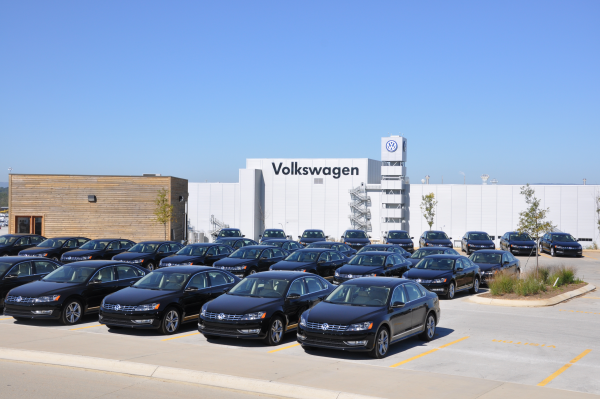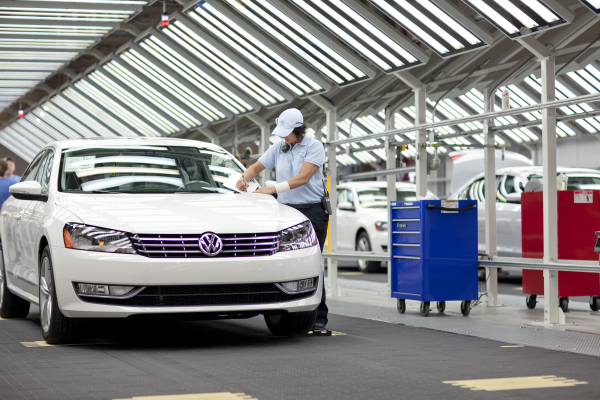 Volkswagen's Chattanooga facility manufactures the new Passat, which is seen as one of the most fuel economic cars on the market.
Volkswagen's Chattanooga facility manufactures the new Passat, which is seen as one of the most fuel economic cars on the market.
This is part II in an interview series with Volkswagen Chattanooga's Environmental Specialist, Ron Drumeller, about Volkswagen's approach to environmental management. Read part I.
ERA: Think Blue – tell us about it.
RD: Think Blue is a campaign of sustainable transportation, and focuses on designing and producing cars that are environmentally sound and a pleasure to drive. Volkswagen has committed itself to the principles of what we call Think Blue, and our factory-- the “Think Blue Factory” -- is proof of Volkswagen’s worldwide commitment to the environment. Our company accepts responsibility for the continuous improvement of the environmental compatibility of our products, and for the increasingly conservative use of our natural resources. So, at all of our locations, the VW group works hand in hand with the local authorities to make sure we’re building a socially and ecologically sustainable development process.
ERA: Can you tell us about Leadership in Energy & Environmental Design (LEED) and how it affected the facility design?
RD: Sure - No matter where we build in the world, we apply 21 environmental principles and policies. The Volkswagen board of management and environmental steering group ensure these 21 principles get implemented and followed. So, what we wanted to do in Chattanooga was use those 21 principles and move towards LEED – which is leadership in engineering and environmental design. That is a performance measurement for environmental & human health, sustainable site development, water savings, energy efficiency, material selection and indoor quality.
This also includes emissions reductions and sustainability, so the LEED certification provided steps and gave us some guidelines on what to follow with regards to efficiencies to aim for & materials to use.
ERA: Were there any extra steps taken during the construction of the site?
RD: At the beginning, during the construction process, we had all our contractors segregate their construction waste into separate containers. This means that during the building of the plant, about 75% of the construction waste created was recycled. We also insulated the whole plant with 6 inches of mineral wool insulation, which is also a recyclable material. This meant a 43% cost savings compared to a traditional plant. The wood used during the construction was recycled by donating it to a local company called ‘Create Here’, which used it in a number of different creative projects.
Charles Clay is a local recycler who received a large quantity of wooden pallets from the Volkswagen facility.
ERA: I heard you took some steps to reduce the heat on your roof
RD: Yes, we also installed a white membrane on the facility’s roof to reduce the heat island effect, which is an interesting phenomenon. It basically means that the surrounding air temperatures for urban areas are significantly higher than the surrounding rural area. We wanted to achieve the highest possible certification for LEED and one of the ways to do that is to use more light reflecting and less heat absorbing material on the roof. This reduces the energy costs for the building and helps the aquatic ecosystem by not allowing a rapid temperature change in the surrounding waterways from the heat transferring to the stormwater. We also used a light colored concrete around the site to reduce this effect, instead of dark asphalt which gives off a great deal of heat.
ERA: What has VW done in terms of water savings and quality control?
RD: Around the site and in the parking lot we have what is called bioswales. Bioswales are constructed with rock & plants and they allow the storm water collection to run off into green spaces, so it has a natural filtration to it. It slows and cools the stormwater runoff from the paved surfaces, decreasing the erosion potential of the receiving waterways. This helps the aquatic ecosystem by not having a rapid temperature increase & it helps the wildlife by keeping down the growth of algae and population of unwanted bacteria. We also have 3 storm water collection tanks in the plant, above the restrooms. So, there are various areas that collect water and are divert to these 3,000 gallon tanks with vortex filters where they’re pumped to restrooms for flushing. Each area on the roof can collect up to 650,000 gallons of water per year. That’s over 700,000 flushes, so that helps.
ERA: What has VW done to save energy?
RD: Electric tuggers are used to deliver materials without using gas powered forklifts. We also take advantage of natural light in the office space with skylights, to reduce the amount of energy needed during the day. Low level LED lights are used in the parking lot, and using 50% less energy, while illuminating our parking lot at night. T5 fluorescent light bulbs are used to minimize our energy usage by up to 20%.

If you missed Part I, read it here.
|
About the Author: Ross O'Lochlainn is the Environmental Researcher & Online Content Manager for ERA Environmental Management Solutions. You can find Ross on Google+, LinkedIn & ERA's Environmental Compliance Blog |
This Blog Was Co-Authored By:


Tags:
Environmental ManagementApril 11, 2012
Comments